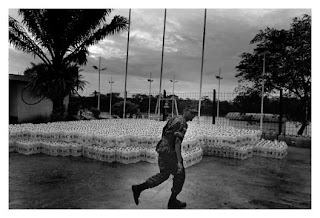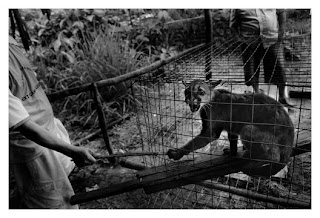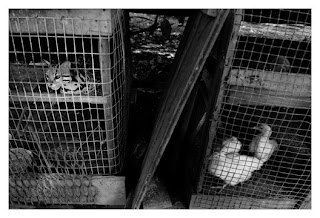Coca - Payamino - Coca
I arrived in Coca on wednesday afternoon. The first thing that I saw was big tankers on the street, filling up the water tanks of houses. Coca is officially in a state of emergency. Every day at 6.30 am tankers supplied by OCP, fill up with water from the river Payamino and then make the rounds of the city. Here´s the irony, the tankers that supply water usually transport oil. Drinking water is being supplied by Coca Cola and paid by OCP - corporate to the core. Luckily, the authorities gave warning of the spill in time and virtually nobody has fallen sick. When I spoke the mayoress today, she said... "luckily we knew how to react, this happened last year too so we have some previous experience". Yesterday we visited the community of Huataracu, which is about one an hour away and on the banks of the rio Coca, we were not able to speak to anyone. Not only is the community vast but they have also agreed to let the Petrobras set up shop and most of it is actually behind the checkpoint, which we were of course not allowed to pass. We went down to the river bank to have a look and although you can not see large chunks of crude oil it is obvious that the river is in bad shape. It is covered by a thin layer of oil and since the river has been going up and down because of heavy rains the banks are covered in a thin sheen. Ali, Sumiko (two volunteers currently working in San Jose de Payamino) and I accompanied the mayoress on a trip upstream with the OCP engineer in charge of the clean up in this area (there more than a 2ookm of river that have been affected by the spill) and it was interesting to see how the discussion between the two, since one was down playing the impact of the spill while the other was criticising the slow response and the lack of personel (apparently 50 people are working on the clean up operation, but it we saw less than of half of that actively on the river). Most of the operation was centered on filtering the oil off the water with specifically designed foam filters which are stretched out on the surface of the river, but speaking to the engineer it will take months (perhaps a year) for the whole remediation to be completed. Quite a scary thought

Clean up operation on the banks of the Rio Coca

9000 bottles of Dasani (Coca-Cola) await distribution in the Navy Headquarters in Coca
The visit to Payamino was relatively uneventful. I saw and spoke to Lucio and a couple of other people and Ali and Sumiko seem to be doing as well as they can with the resources they have and support they are getting. On the way back we stopped to see a Puma cub (
Puma concolor), which had been caught by the people in Payamino and given to the settler community of Campo Alegre as a tourist attraction. One of my ideas for my book project is to look at the illegal pet trade. This being a blatant example of it. This afternoon we visited someone who kept a "tigrillo" (
Leopardus tigrinus) in their back yard with the chickens. It was good getting the contact of the mayoress, since I was able to tell her about my idea of the book. Next time I come to Coca I will try and show them a proposal and see whether they can help me with some contacts.

Puma in Campo Alegre

Tigrillo in a chicken coop, El Coca


 Breakfast of Champions: Courtesy of AirFrance
Breakfast of Champions: Courtesy of AirFrance 
 Moths and various miscellaneous insects to a white sheet and a light
Moths and various miscellaneous insects to a white sheet and a light Taking a closer look
Taking a closer look One of the hawk-moths (Sphingidae) on the sheet
One of the hawk-moths (Sphingidae) on the sheet 




